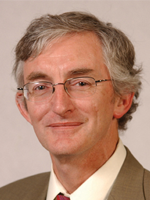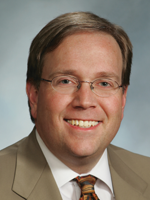
Dr. Clunie
“If you are a single vendor and have acquired your data and have a viewer to view your own data, everything works from input to output. Your engineers are happy. But when you have a different team of engineers from another vendor taking your data and viewing it in a different system, then it becomes much more challenging.” The aim of the DICOM standard, he says, is to anticipate the challenges to ease the way.
Until it’s tried, though, “you don’t realize there are things you haven’t thought of yet,” Dr. Clunie says, describing the DICOM standard as a “paper design of how we think two systems should work in concert.” Not until it’s put to the test, between two different engineering teams, he says, can there be certainty. “We found this out in the critical weeks leading up to Connectathon. Many adjustments had to be made in the days before attendees started coming through the door.”
“One of the coolest things about Connectathon,” says Dr. Clunie, was seeing engineers from competing companies working together to solve a problem, “even though their project managers might be arch competitors.”
Philips, Ventana (Roche), and Leica Biosystems Aperio Digital Pathology participated with their slide scanners. Pathcore and AidPath provided their viewers, and Pathcore provided its PACS. “This first Connectathon was a starting point, not an ending point,” says Dr. Pantanowitz.

Dr. Beckwith
Dr. Beckwith says the reactions of attendees were positive. “There was a high level of interest, and attendees could see for themselves that systems from different vendors worked together just fine.” Interest was high, too, he says, in a panel discussion moderated by Drs. Pantanowitz and Parwani and in which he participated. “We were the next-to-last presentation at the meeting—a time slot that can be the kiss of death to a presentation. But instead people stayed to discuss what they had seen. They were genuinely excited to see that interoperability is possible.” Panelists talked about lessons learned and what can be improved with DICOM supplements. “We improved the process and made progress on the spot. At the same time, we spread the word about DICOM and interoperability in digital pathology. It was powerful,” Dr. Beckwith says.
Dr. Pantanowitz recalls the crowd as standing-room only: “Pathologists came, scientists came, vendors came.” And for the first time, he says, “everyone agreed to do a ‘handshake’ to push the competitive nature of digital pathology aside for a brief time to accomplish this. It’s a big deal. We’re taking down the barriers in digital pathology one by one.”
Most telling, Dr. Clunie says, was that Philips, with the only FDA-approved platform for primary diagnosis in the U.S., was a participant. “Philips has an opportunity to market a system that is completely closed, yet with its global experience it recognizes the need to go beyond that. When Philips comes to a Connectathon and sends out DICOM images, even though it doesn’t have to, that is very telling.”
Dr. Beckwith says it foretells the expansion of digital pathology platforms and the FDA’s expectation of the same. “I hear other companies will soon be making submissions to the FDA for primary diagnosis,” he says. “And because the FDA has had experience with radiology, which also began with a closed system and then was expanded to interoperable mix-and-match parts, they are comfortable with this progression.”
In fact, after the Connectathon panel discussion, the FDA offered the final presentation at Pathology Visions during which “an FDA representative said that interoperability and demonstration of willingness to adopt a standard in the industry is something the FDA looks favorably upon,” Dr. Pantanowitz says, making it easier for the FDA to approve a system.
Experts maintain that once two or three systems are available, users and potential users will start to identify the imperative for flexibility. “They may wish to replace a scanner with equipment from vendor A, use a storage archive from vendor B, and view it on equipment from vendor C,” explains Dr. Beckwith. “Then they may wish to use various artificial intelligence tools from different companies to analyze the digital images. This opens the floodgates to computer-assisted diagnoses. It will all be possible, and no one will want to be locked into just one manufacturer.”
Because having these options is so important, Drs. Beckwith, Clunie, Pantanowitz, and Parwani urge those considering entering the digital pathology space to include in their contracts with the companies a demand for interoperability within a specified time frame. “Have it in writing that the system will be DICOM compliant within 12 or 18 months,” suggests Dr. Beckwith. “It will buy a lot of flexibility down the road and will save a great deal of money in the long run.”
True standardization and interoperability in digital pathology will be a big win for pathology and patients. “We will be able to share images with the entire enterprise,” Dr. Pantanowitz says. “That opens a lot of opportunities. We will be able to share images with patients through a portal, to help educate them and lend better decision support. We will be able to share images with radiology and thereby possibly improve pathology-radiology correlations. We will be able to send images to experts in specific areas, in any geographic location, and expand consultations. We will be empowered to take advantage of artificial intelligence and computational analysis—who knows what that can uncover and detect for us?”
With true interoperability, Dr. Parwani, too, expects to see greater collaboration among radiology, pathology, oncology, and other “-ologies.” He foresees more automation in anatomic pathology and more widespread use of digital imaging because of the ability to start standardizing and integrating data flow. “This will enable us to make pathology a center of information. The work we are doing will no longer be limited to the pathology department, but instead it will move into the entirety of the health care solar system. The data flow will no longer stop at the microscope.”
“There are no more dead ends,” as Dr. Parwani puts it. “Now we are on a data continuum. There was a time this was all just like writing chalk on a blackboard in an attempt to conceptualize things. At Connectathon we turned that concept into action.”
[hr]
Valerie Neff Newitt is a writer in Audubon, Pa.
 CAP TODAY Pathology/Laboratory Medicine/Laboratory Management
CAP TODAY Pathology/Laboratory Medicine/Laboratory Management
